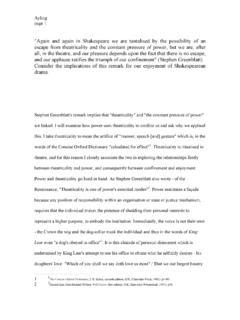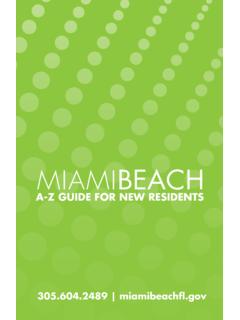Transcription of The History of Glass Production in East Shropshire by Paul ...
1 THE History OF BROAD & BOTTLE Glass Production IN east Shropshire BY PAUL ANDREW LUTER Page 1 (Top) the Tablet erected inside Shifnal Saint Andrews Church in memory Of Richard of Wrockwardine Wood Glasshouse. The Wrockwardine Wood Rectory originally built as the Glasshouse Managers House in house still stands today. Page 2 Early Beginnings at Blower Park This Booklet on the History of Broad and Bottle Glass Production in east Shropshire since the late 16th Century shows how Shropshire played a vital part in the History of Glass Production , a part that is generally ascribed only to the Counties of Staffordshire and Worcestershire, particularly the Stourbridge and Kingswinford areas. Shropshire Glassmaking was stimulated by men from outside the county, namely families of French Lorrainers, Tyzack, Henzey, Tittery, Bongar and Cockery, moved from Wisborough Green and surrounding areas in the County of Sussex to an area known as Bishops Wood which lies between Eccleshall in Staffordshire and Market Drayton in Shropshire and is in the Diocese of Lichfield.
2 (1) The Parish Registers of Eccleshall, and Cheswardine, near Market Drayton, Shropshire show specific records of Frenchmen moving into the area, the earliest being the baptism at Eccleshall of Peregrinus Henzey on the 28th of October 1586. Most of these references clearly indicate sites at Knowle Wood and Blore (or Blower) Park about 4 miles from Eccleshall where once stood a medieval village and where an adjoining castle was the residence for the Bishops of Lichfield. (2) It was at Blower Park and Knowle Wood that Glass Production in Shropshire first appeared. Window Glass and crude Bottle Glass was produced, possibly for the Bishop of Lichfield.(3) Although the prominent families of Henzey, Tyzack and Tittery seemingly set up a glasshouse in June 1585, the Henzey s subsequently left the Cheswardine area for a new location at Blithfield , about 20 miles way, tempted, it seems, by better prospects.
3 However, two new French families arrived at Blower Park, namely those of de Bigo and De Houx who carried on Production there until about 1609, when the Cheswardine parish register records the burial of Moses de Howe, a is possible that the glassworks existed for some time after that, although it is doubtful whether it was any longer producing Glass . The final reference to a glasshouse is dated 11th October 1639 when Constance Williams of the Glasshouse was buried at Cheswardine. The Henzeys, meanwhile continued Glass Production at Blithfield, but after only 14 months on 22nd August 1586, Ambrose Henzey died, leaving Edward Henzey to carry on Production there until 1602, when it seems he returned to Sussex with his wife Sarah. He later came back to Staffordshire,however,when he died in 1621 he is described in his Will as Glassmaker of Amblecote in the Parish of Old Swinford,Staffordshire.
4 Mansell s 1615 Patent During the period 1592 to 1615 the monopoly on the English Glass Trade, including Shropshire , had been in the hands of Sir Jerome Bowes, but in 1615 it was transferred to Sir Robert Mansell, who had gained his knighthood at Cadiz in 1596, and who later from 1606-1610 commanded the Narrow Seas Fleet. In 1615, now Vice-Admiral,Mansell took out a Glass Patent which was attacked in Parliament in 1621. (4) The Patent established that coal could be used as an alternative fuel for glassmaking instead of the charcoal which used up large numbers of trees. Page 3 The Lorrainers in Shropshire and Staffordshire heard of this through the extensive experiments carried out into the industrial use of pit coal on Lord Dudley s land at Kingswinford. However neither Lord Dudley or Paul Tyzack, head of the Tyzack Lorrainers, applied for monopoly at that time, preferring to wait until the processes had been perfected.
5 Mansell, however, with the Navy in mind, gave his full support to the patent which would lead to the saving of much wood for use in the King s fleet. In December 1615 the Henzey s had journeyed from Sussex to join the Tyzacks at Old Swinford. Interestingly, one of the Lorrainers working under Tyzack at Colemans Glassworks was a man Abraham Bigo (born 1585). In November 1617 Bigo left Colemans and set up his own works for manufacturing green drinking glasses on the Isle of Purbeck, near Portland in Dorset. However, on the 10th July 1621 the Privy Council took out a warrant for Bigo s arrest as he seemed to be non-compliant with the Kings ban, and owed 3 years rent to Mansell. Abraham Bigo ignored the order and went to Ireland, where he carried on Glass Production in Kings County . (6) Expansion in Kingswinford In 1658 Colemans Glassworks was destroyed by fire.
6 It was at this time that, in order to raise money to rebuild the glassworks,Paul Tyzack entered into a contract with three men- Abraham Bigo II ( ), Zechariah Tyzack, his cousin, and Robert Foley, a wealthy local Ironmaster. By 1666, Tyzack, Bigo and Foley were partners in a Glasshouse at Withymoor near Amblecote producing window and bottle Glass on a site held on lease from Henry Grey of Enville, Staffordshire. However, Foley s fruitful Ironworks located in the rich coal seams at Wombridge in Shropshire held the interest of Bigo as a possible site for further expansion. Surface Coal was in plentiful supply there, and this was desirable.(7) The parish registers of Old Swinford show that Abraham Bigo had a son, a son, the third Abraham, baptised on 9th December 1655, who was to re-ignite Broad and Bottle Glass Production after 60 years of dormancy. In 1676 Abraham III and his father moved their interest to Snedshill, near Oakengates in Shropshire , where they set up a glasshouse in an old farm they produced window Glass ,using the hand cylinder process,and dark green Glass bottles for the wine trade.
7 This move of Abraham II and his son coincided with the break up of Bigo s partnership with Tyzack and Henzey in Coleman s Glassworks in 1677.(8) The source of the raw materials for the Snedshill glassworks is not documented, but there is reason to believe that, because of the business links between Foley and Bigo, Scoria of Forges , or slag came from Foley s Iron Mill at Wombridge about a mile may of come from Preston upon the Weald Moors and sand from Wombridge or Ketley, although we cannot be certain of the latter. Coal fuel for Production could also of come from local sources, perhaps the pits of Richard Hartshorne, Master Collier of nearby Coalpit Bank, Wombridge, or from Richard Ball of Quobb Lane,who was mining coal at Mumporn Green,Snedshill from 1st December 1671.(9) Page 4 Little is known of the exact site of the Snedshill glassworks,other that it was on the Oakengates side of Shifnal parish.
8 No documents or accounts have survived,but what is certain is that window and bottle Glass Production continued for at least 20 years, for John Houghton s periodic Husbandry of Trade of 15th May 1696 confirms that Production was in progress that year.(10) The baptisms of six children of Abraham Bigo III and Cicely his wife appear in the Register of St Andrews Church, Shifnal: Orlando 1683,Phillip 1684, Elizabeth 1686, Mary 1691, Alice 1693 and Sarah 1699.(11) An interesting insight into the life of the Bigo family has emerged through the recent discovery of Wrockwardine Poor Law documents, which show that on 30th December 1713, Abraham Bigo of Oakengates,Gentleman, stood surety for 100 in the matter of a bastard child expected by Elizabeth Motterham of Bunbury,Cheshire, the father of which was claimed to be Orlando Bigo, Abraham s eldest son.(12) Abraham Bigo s Will is dated 3rd February 1729, and his Inventory dated 27th April 1730 taken by John Watkiss and John Hill, amounts to the value of , including the contents of a Brewhouse and Buttery, left to his children.
9 (13)Cicely Bigo, his wife, was buried at Shifnal on 31st March 1727, and Abraham was buried also at Shifnal, on 12th March 1729. Orlando Bigo, Abraham s eldest son, was buried at Shifnal as a Pauper of Oakengates on 9th March 1741. The Batchelor Family Another family who had been linked with the original Lorrainers and whose mark was left on the History of Salopian glassmaking was the Batchelor family. In 1691, Benjamin Batchelor, a glassmaker from Amblecote was granted demise of the Dennis Glassworks at Amblecote for 999 years. Here they produced bottles and drinking glasses. In 1697 an Elisha Batchelor along with Ananias Henzey, presented an appeal for the repeal of the excise which had been introduced by the Glass Act of 1695, and which is believed to have brought about the end of Production at Snedshill. (14 ) On 1st May 1703, Elijah, Humphrey and Benjamin Batchelor Sr. became members of one of the first cartels in England.
10 They, along with Ananias, John and Joshua Henzey and Samuel, William and Edward Tyzack, pledged to supply Benjamin Perrot, a merchant of Bristol with bottles for the export trade. The Bristol Port Records in 1706 show that their trade was extensive. For example, the records for 7th February 1706 show that Henry Tyzack sent 2,400 English Glass bottles and 2,100 drinking glasses down the Severn to Bristol, on 5th March 3,000 bottles and 1,200 glasses, and on 30th April 1,200 glasses. Further entries show a total of over 20,000 bottles were exported through this cartel from Bristol, including in 1706 three shipments to Jamaica. The cartel supplied Perrot at Bristol from 1703 to 1714. (15) Benjamin Batchelor Sr had Married Sarah Hartland at Sedgley, Staffordshire on 25th July 1702, and they had 4 children baptised there: Elizabeth, baptised 27th January 1703; Mary, baptised 7th April 1706; Sarah, baptised 1st April 1705 and Benjamin, baptised 22nd April 1711.
![INDEX [www.circa.org.im]](/cache/preview/6/b/6/3/4/6/b/5/thumb-6b6346b51bd892fd2cf4acc39be9c895.jpg)





